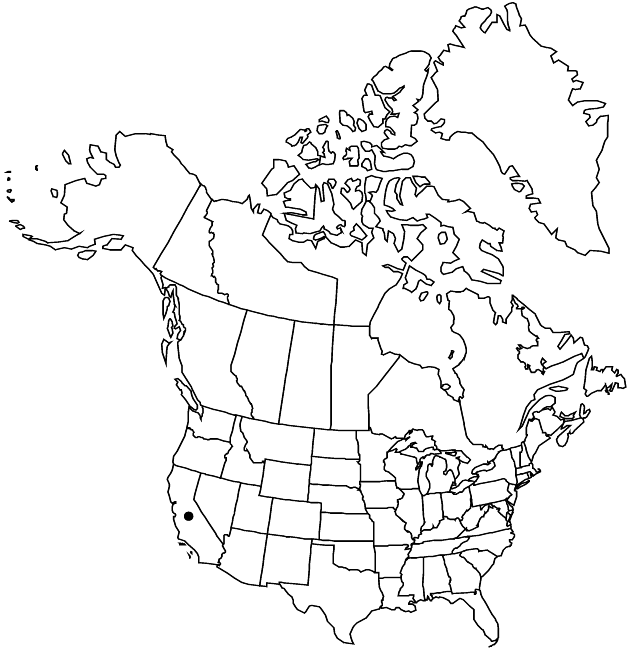Difference between revisions of "Lasthenia platycarpha"
Man. Bot. San Francisco, 205. 1894.
FNA>Volume Importer |
imported>Volume Importer |
||
| (6 intermediate revisions by 2 users not shown) | |||
| Line 8: | Line 8: | ||
}} | }} | ||
|common_names=Alkali goldfields | |common_names=Alkali goldfields | ||
| − | |basionyms={{Treatment/ID/ | + | |special_status={{Treatment/ID/Special_status |
| + | |code=E | ||
| + | |label=Endemic | ||
| + | }} | ||
| + | |basionyms={{Treatment/ID/Basionym | ||
|name=Burrielia platycarpha | |name=Burrielia platycarpha | ||
|authority=A. Gray | |authority=A. Gray | ||
| + | |rank=species | ||
| + | |publication_title=in W. H. Emory, Rep. U.S. Mex. Bound. | ||
| + | |publication_place=2(1): 97. 1859 | ||
}} | }} | ||
|synonyms={{Treatment/ID/Synonym | |synonyms={{Treatment/ID/Synonym | ||
|name=Baeria platycarpha | |name=Baeria platycarpha | ||
|authority=(A. Gray) A. Gray | |authority=(A. Gray) A. Gray | ||
| + | |rank=species | ||
}} | }} | ||
|hierarchy=Asteraceae;Asteraceae tribe Heliantheae;Asteraceae (tribe Heliantheae) subtribe Baeriinae;Lasthenia;Lasthenia sect. Platycarpha;Lasthenia platycarpha | |hierarchy=Asteraceae;Asteraceae tribe Heliantheae;Asteraceae (tribe Heliantheae) subtribe Baeriinae;Lasthenia;Lasthenia sect. Platycarpha;Lasthenia platycarpha | ||
| Line 30: | Line 38: | ||
|elevation=0–100+ m | |elevation=0–100+ m | ||
|distribution=Calif. | |distribution=Calif. | ||
| − | |discussion=<p>Lasthenia platycarpha is known only from highly saline soils and is frequently found with species of sects. Hologymne and Ornduffia, particularly L. fremontii. In the northern part of its range, L. platycarpha is more robust and has longer pappus scales and more densely pubescent peduncles. Plants with entire leaves resemble species of sect. Amphiachaenia; L. platycarpha does not have anthochlor pigments that turn red in aqueous alkali.</p> | + | |discussion=<p><i>Lasthenia platycarpha</i> is known only from highly saline soils and is frequently found with species of sects. Hologymne and Ornduffia, particularly <i>L. fremontii</i>. In the northern part of its range, <i>L. platycarpha</i> is more robust and has longer pappus scales and more densely pubescent peduncles. Plants with entire leaves resemble species of sect. Amphiachaenia; <i>L. platycarpha</i> does not have anthochlor pigments that turn red in aqueous alkali.</p> |
|tables= | |tables= | ||
|references= | |references= | ||
| Line 39: | Line 47: | ||
-->{{#Taxon: | -->{{#Taxon: | ||
name=Lasthenia platycarpha | name=Lasthenia platycarpha | ||
| − | |||
|authority=(A. Gray) Greene | |authority=(A. Gray) Greene | ||
|rank=species | |rank=species | ||
| Line 53: | Line 60: | ||
|publication title=Man. Bot. San Francisco, | |publication title=Man. Bot. San Francisco, | ||
|publication year=1894 | |publication year=1894 | ||
| − | |special status= | + | |special status=Endemic |
| − | |source xml=https:// | + | |source xml=https://bitbucket.org/aafc-mbb/fna-data-curation/src/2e0870ddd59836b60bcf96646a41e87ea5a5943a/coarse_grained_fna_xml/V19-20-21/V21_865.xml |
|tribe=Asteraceae tribe Heliantheae | |tribe=Asteraceae tribe Heliantheae | ||
|subtribe=Asteraceae (tribe Heliantheae) subtribe Baeriinae | |subtribe=Asteraceae (tribe Heliantheae) subtribe Baeriinae | ||
Latest revision as of 20:15, 5 November 2020
Annuals, to 30 cm. Stems erect, branched proximally, glabrous or woolly to villous, especially distally. Leaves linear, 10–60 × 1–2+ mm (simple blades or single lobes), margins usually lobed, sometimes entire, faces glabrous or hairy. Involucres obconic, 6–8 mm. Phyllaries 6–9, elliptic to ovate, glabrous or villous. Receptacles conic, muricate, glabrous or sparsely hairy. Ray florets 6–13; laminae elliptic, 7–8 mm. Anther appendages deltate. Cypselae black to gray, narrowly clavate, 1.5–3.5 mm, hairy; pappi of 4–6 white or yellowish, lanceolate to ovate, aristate scales. 2n = 8.
Phenology: Flowering Mar–Apr.
Habitat: Alkali flats
Elevation: 0–100+ m
Discussion
Lasthenia platycarpha is known only from highly saline soils and is frequently found with species of sects. Hologymne and Ornduffia, particularly L. fremontii. In the northern part of its range, L. platycarpha is more robust and has longer pappus scales and more densely pubescent peduncles. Plants with entire leaves resemble species of sect. Amphiachaenia; L. platycarpha does not have anthochlor pigments that turn red in aqueous alkali.
Selected References
None.
